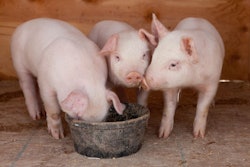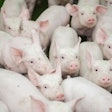
Amino acid recommendations may be insufficient for antibiotic-free pig diets, study concludes
Young pigs raised on antibiotic-free diets may require a different balance of amino acids than the conventional wisdom suggests.
According to a study led by animal health manufacturer Novus International and published in the journal Animals, nursery pigs raised without antibiotics achieved better growth performance on diets with increased total sulfur amino acid-to-lysine ratios. In the first 21 days post-weaning, the optimal ratio may be 13-31% higher than the most recent recommendations from the National Research Council. Pigs in the late nursery period may require 5% more sulfur amino acids to lysine when raised without antibiotics, the study found.
“From the results, it’s pretty clear,” said Ping Ren, swine nutrition research scientist for Novus International, and the lead author on the study. The exact percentages may not apply in all circumstances, he said, “ but, overall, I would increase the requirement for pigs without antibiotics.”
The findings aren’t entirely surprising, according John Patience, a professor emeritus of animal science at Iowa State University. Research over the past several years has pointed toward the likelihood that pigs raised on antibiotic-free diets require more sulfur amino acids. This study, he said, further solidifies that possibility by providing a direct comparison of pigs raised with and without antibiotics.
Yet Patience said more research and data is needed to prove not only if antibiotic-free diets require more sulfur amino acids, but also why this is the case. There are multiple reasons why young pigs may have a higher amino acid requirement. Antibiotics cause changes to the gut bacteria and intestinal tissues, which changes the way nutrients are absorbed, Patience said. Or, Ren said, the absence of antibiotics could mean more infection, inflammation and stress, especially in newly weaned pigs, who seem to have the highest sulfur amino acid requirements.
But just because something makes sense logically, Patience said, doesn’t mean it’s true — and there is also evidence to suggest that the amino acid requirement doesn’t change when antibiotics are removed from the diet.
“We’ve been using antibiotic growth promoters since the 1950s — that’s a long time ago — and we still don’t really know why we get a growth response,” Patience said. “We have an idea and some theories supported by research, but we really don’t know exactly how they work. When we say, ‘they don’t have antibiotic growth promoters, it makes sense this will happen,’ we’re assuming we know what the antibiotic growth promoters are doing, and we don’t.”
Research on the topic is essential, Ren said, because of the worldwide movement way from the use of antibiotics in animal diets. With restrictions on the use of antibiotics growing in the U.S, the EU and in most of Asia, the number of pigs raised without antibiotics is growing, Ren said.
And while there’s still more to learn about what it means to remove antibiotics from pig diets, Patience said, the evidence on amino acids is compelling enough that if he were producing antibiotic-free pork, he’d consider setting up a feed trial of his own, just to be sure.
“I think there is enough information out there that I’m going to look at this very, very seriously,” he said.


















